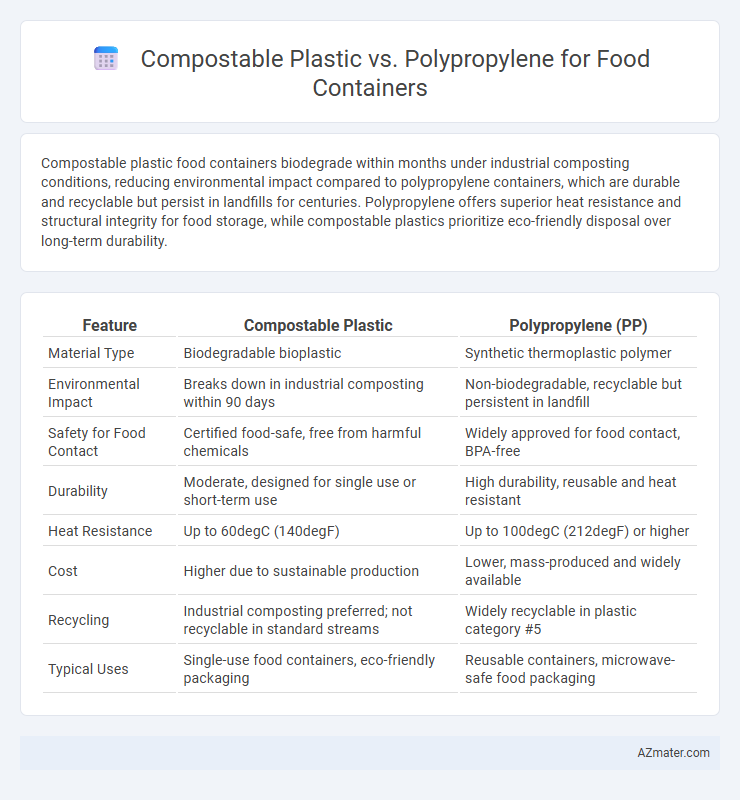Compostable plastic food containers biodegrade within months under industrial composting conditions, reducing environmental impact compared to polypropylene containers, which are durable and recyclable but persist in landfills for centuries. Polypropylene offers superior heat resistance and structural integrity for food storage, while compostable plastics prioritize eco-friendly disposal over long-term durability.
Table of Comparison
| Feature | Compostable Plastic | Polypropylene (PP) |
|---|---|---|
| Material Type | Biodegradable bioplastic | Synthetic thermoplastic polymer |
| Environmental Impact | Breaks down in industrial composting within 90 days | Non-biodegradable, recyclable but persistent in landfill |
| Safety for Food Contact | Certified food-safe, free from harmful chemicals | Widely approved for food contact, BPA-free |
| Durability | Moderate, designed for single use or short-term use | High durability, reusable and heat resistant |
| Heat Resistance | Up to 60degC (140degF) | Up to 100degC (212degF) or higher |
| Cost | Higher due to sustainable production | Lower, mass-produced and widely available |
| Recycling | Industrial composting preferred; not recyclable in standard streams | Widely recyclable in plastic category #5 |
| Typical Uses | Single-use food containers, eco-friendly packaging | Reusable containers, microwave-safe food packaging |
Introduction: The Need for Sustainable Food Packaging
Compostable plastics offer a renewable alternative to conventional polypropylene in food containers, addressing growing environmental concerns related to plastic waste and pollution. Polypropylene, widely used for its durability and low cost, contributes significantly to landfill accumulation and ocean pollution when improperly disposed. Sustainable food packaging solutions prioritize compostable materials to reduce carbon footprints and promote circular economy practices in the food industry.
What Are Compostable Plastics?
Compostable plastics are bio-based materials designed to break down into natural elements within a composting environment, reducing environmental impact compared to traditional plastics. These plastics are certified to disintegrate into organic matter without leaving toxic residues, making them suitable for food containers that support sustainable waste management. Unlike polypropylene, which is derived from petroleum and resistant to biodegradation, compostable plastics offer a renewable, eco-friendly alternative for disposable food packaging.
Understanding Polypropylene: Features and Uses
Polypropylene is a thermoplastic polymer known for its durability, chemical resistance, and high melting point, making it ideal for food containers that require microwave and dishwasher safety. Its lightweight yet sturdy nature ensures excellent barrier properties against moisture and grease, preserving food freshness effectively. Widely used in the food packaging industry, polypropylene containers offer cost-efficiency and recyclability, although they are not biodegradable like compostable plastics.
Environmental Impact: Compostable Plastics vs Polypropylene
Compostable plastics, derived from renewable resources like cornstarch, break down into non-toxic substances within industrial composting conditions, significantly reducing landfill waste and greenhouse gas emissions compared to traditional polypropylene. Polypropylene, a petroleum-based plastic, is durable and recyclable but persists in the environment for centuries, contributing to plastic pollution and microplastic contamination in soil and waterways. Choosing compostable plastics for food containers supports circular economy principles and lowers carbon footprint, whereas polypropylene's environmental impact depends heavily on recycling efficiency and waste management infrastructure.
Food Safety: Comparing Health and Contamination Risks
Compostable plastics for food containers reduce environmental impact but may pose challenges in heat resistance and potential chemical migration, increasing contamination risks under high temperatures. Polypropylene offers superior food safety due to its high thermal stability, low chemical leaching, and FDA-approved usage for direct food contact, making it more reliable in preserving food integrity. Consumer health concerns are minimized with polypropylene, while ongoing research is needed to fully assess the long-term safety of compostable alternatives during various food storage and heating conditions.
Durability and Performance in Everyday Use
Compostable plastics, typically made from plant-based materials like PLA or PHA, offer eco-friendly disposal but generally have lower durability and heat resistance compared to polypropylene (PP), leading to potential deformation or breakage under high temperatures or repeated use. Polypropylene provides excellent chemical resistance, high heat tolerance up to around 120degC, and robust structural integrity, making it ideal for microwaveable, reusable, and long-term food storage containers. In everyday use, polypropylene containers outperform compostable plastics in durability, maintaining shape, sealing capability, and resistance to wear, while compostable alternatives prioritize biodegradability over extended performance.
Cost Analysis: Which Material is More Economical?
Compostable plastics typically present higher upfront costs compared to polypropylene due to raw material expenses and production processes. Polypropylene benefits from economies of scale and widespread availability, making it a more cost-effective option for large-scale food container manufacturing. Long-term cost analysis must also consider environmental disposal fees, where compostable plastics may reduce waste management expenses despite their initial price premium.
End-of-Life Disposal: Composting vs Recycling
Compostable plastics for food containers break down in industrial composting facilities within 90 to 180 days, reducing landfill waste but requiring specific conditions such as high heat and moisture. Polypropylene containers are widely recyclable through standard municipal recycling programs, promoting material recovery and reuse but often facing contamination challenges that can lower recycling efficiency. Proper end-of-life management depends on local infrastructure availability, where compostable plastics contribute to organic waste streams while polypropylene supports circular economy goals through mechanical recycling.
Regulatory Standards and Certifications
Compostable plastics for food containers must meet ASTM D6400 or EN 13432 standards, ensuring biodegradability and safe composting in industrial facilities, while polypropylene (PP) complies with FDA 21 CFR 177.1520 for food contact safety, emphasizing chemical resistance and durability. Certification bodies like BPI and TUV Austria Cert validate compostable plastics, whereas polypropylene's food-grade status is confirmed through regulatory approval rather than compostability certification. Regulatory adherence for compostable plastics targets environmental impact reduction, contrasting with polypropylene's focus on food safety and reuse compliance.
Choosing the Right Food Container Material
Compostable plastics offer eco-friendly benefits by breaking down under industrial composting conditions, reducing landfill waste and environmental impact. Polypropylene, a durable and heat-resistant plastic, provides strong barrier properties and is widely recyclable, making it suitable for long-term food storage and microwave use. Choosing the right food container material depends on prioritizing environmental sustainability with compostable options or durability and recyclability with polypropylene.

Infographic: Compostable plastic vs Polypropylene for Food container
 azmater.com
azmater.com